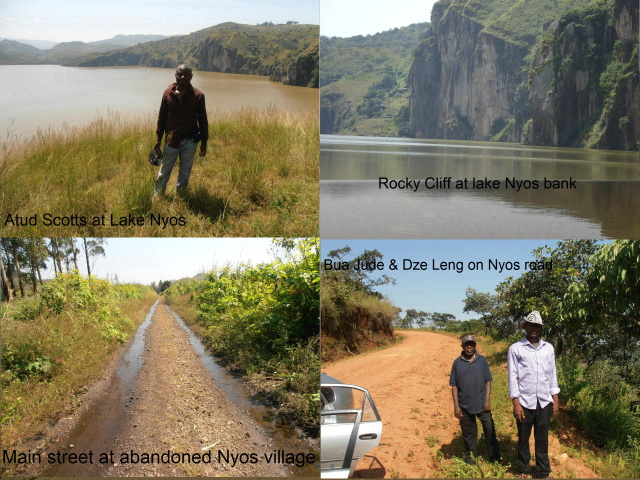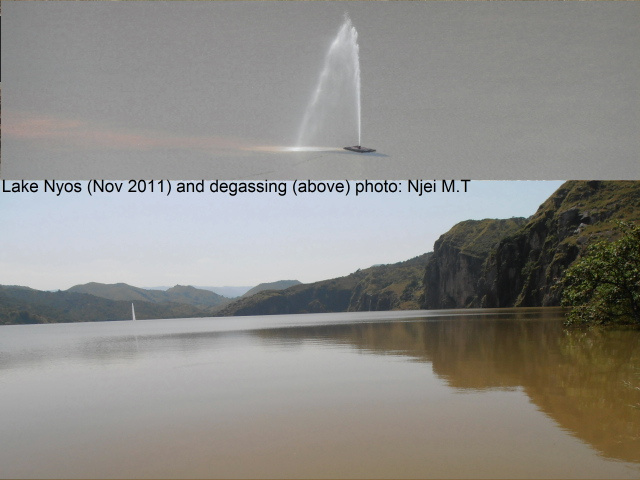20 Nov 2011
Last year, I visited one of the resettlement camps of the lake Nyos victims (see article).
http://www.njeitimah-outlook.com/articles/article/2076041/145664.htm
This year I decided to visit Lake Nyos proper. I took off from Douala with a colleague (Atud Scotts) on Friday Nov. 11 and spent the night in Batibo, near Bamenda. On Saturday, we set off on the first leg of our two-days’ trip to Lake Nyos. On the program of the 120km journey to Wum, we had to visit three lakes (Oshen, Ilum, Wum) and the Menchum waterfall.
Of the three lakes visited on that first day, Lake Oshen still remains a very unique lake. This is my third trip to this lake in seven years and the lake has had three different colours during the three trips.

Different faces of Lake Oshen (photo: Njei M.T)
Read my 2005 article about this lake at this link http://www.njeitimah-outlook.com/articles/article/2076041/28543.htm
Lake Ilum and lake Wum are two beautiful blue coloured lakes. Due to the extended rainy season, the Menchum waterfall still had its punches. We could not visit Lake Kuk in Bafmen due to time constraints.
On Sunday, after much debate whether we should hire motorbikes for the 40 kms journey from Wum to Nyos (due to uncertainty about the state of the road), we finally decided to take our car along. We took two people from Wum with us including a young man Bua Jude who hails from Nyos and whose grandparents and other relatives perished in the 1986 disaster (see article on disaster at this link) http://www.neatorama.com/2007/05/21/the-strangest-disaster-of-the-20th-century/
On the Wum Nyos trajectory there is the town of Weh (8kms from Wum). From Weh, you will have to pass through Kumfutu and Chah villages before getting to Nyos. The road from Weh to Nyos is one of the loneliest roads for motorists. I think this is more of a problem to worry about than the bad state of the road. Throughout our journey from Weh to Nyos and back we never saw any other car. When on this type of road you have to pray that you do not have a car breakdown or be confronted by armed bandits. The extensive hills on the way to Nyos have been occupied by cattle rearing Borroros.
On approaching Nyos we were shown valleys where people perished. The Cameroon government had evacuated all people within a certain radius from the lake after the disaster. Very few people are gradually returning to the area. For now most are using their ancestral land for farming while living elsewhere. “Whenever I come here with my mother to farm, she cries all day” Said Bua who was born in Bafoussam where his father worked as a soldier at the time of the incident. “My grandmother came to assist my mother in Bafoussam just around the time I was to be born. Shortly after my birth, she went back to Nyos to harvest some food and bring back to Bafoussam. The disaster occurred in the night before the morning she was to leave Nyos for Bafoussam and she perished”. Bua who was born on the 14thAugust 1986 was just one week old when his grand-parents perished alongside with some 1700 people in the Lake Nyos gas disaster.

We arrived lake Nyos shortly before midday on Sunday. There is an outpost of the Rapid Intervention Brigade of the Cameroon army (popularly known by its French abbreviation B.I.R) at the lake. The soldiers entered our ID information in a ledger and allocated one of them to accompany us to tour the lake. The lake had its characteristic light brownish colour. A fountain-like jet could be clearly seen in the lake spewing out gas through a shaft inserted into the water.
I had read many alarming stories from Nigeria about the imminent collapse of the walls containing lake Nyos. It was said that if that were to happen, millions of gallons of water will come rushing towards Nigeria and engulfing hundreds of villages on its path. I saw no evidence of that type of scenario ever coming to pass. On the contrary I saw a rocky walled lake determined to last a thousand years in its bowl shaped home.
We were told that chunks of rocks occasionally break and fall into the lake from one of its hillside bank and the fear is that if a landslide were to occur, it could send chunks of rocks into the lake that may disturb the equilibrium of the gas below the lake and trigger sudden release of gas that can attain dangerous levels. Ground work is already in progress to construct a devise to contain this problem.
What is clear to any visitor to lake Nyos is that the lake contains a large quantity of gas beneath it. The shaft inserted into the lake can be clearly seen spewing out fountain-like jets of gas from the bottom of the lake. It is a form of controlled release of gas in harmless quantities and at the same time reducing the pressure building up below.

A streak of deeper coloured water could be seen where the gas-spewing jets of water land on the surface. No wonder the waters of lake Nyos will always have a brownish tinge colour as long as the gas below it continues to come out with its turbid coloured water.
After visiting these lakes and Lake Nyos in particular, it is easier to appreciate the scientific explanation of the cause of the 1986 disaster. I know diehard supporters of conspiracy theories may be disappointed but I can now say with certainty that the 1986 disaster was of natural origin.
If your Internet speed permits, the video below is a ‘must watch’
1. Killer Lakes Video documentary (3 parts)
http://www.youtube.com/watch?v=ppbcl-MP76s&feature=related
2. Related article: Understanding the Farmer/Grazier problem in N.W Region of Cameroon
http://www.njeitimah-outlook.com/articles/article/2076046/147014.htm
Njei Moses Timah
|